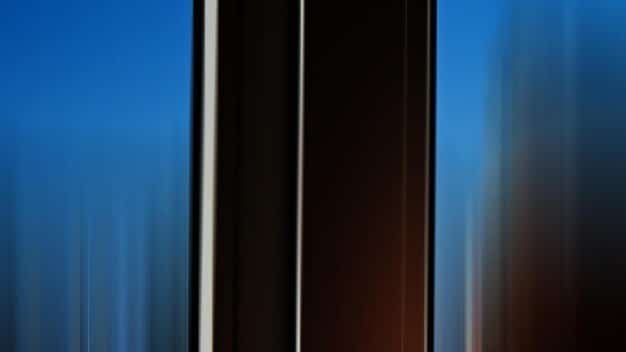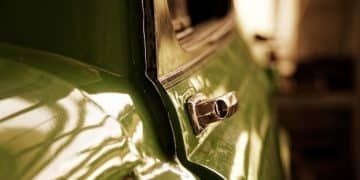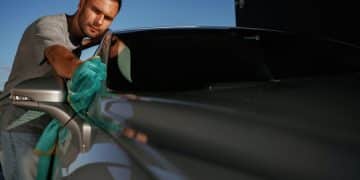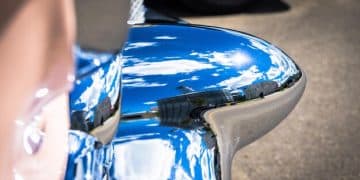DIY Car Window Tinting: A Guide to Sleek Looks & Heat Reduction

DIY car window tinting offers a cost-effective solution to enhance your vehicle’s appearance, reduce heat by up to 60%, and protect against UV rays, providing a cooler and more comfortable driving experience.
Want to give your car a sleek look while drastically reducing heat? DIY car window tinting: Achieve a sleek look and reduce heat by 60% is easier than you might think. This guide provides you with the knowledge and steps to tint your car windows yourself, saving money and enjoying a cooler ride.
Why DIY Car Window Tinting?
Car window tinting offers several benefits, from enhancing aesthetics to improving comfort. While professional installation is an option, DIY window tinting can be a rewarding and cost-effective alternative. Let’s delve into why you might consider doing it yourself.
Cost Savings
Professional window tinting can be quite expensive, especially for larger vehicles or those with multiple windows. By opting for DIY, you only pay for the tint film and a few basic tools, significantly reducing the overall cost.
Personal Satisfaction
There’s a certain satisfaction in completing a project yourself. DIY window tinting allows you to take pride in customizing your vehicle and mastering a new skill.
Flexibility and Control
With DIY, you have complete control over the type of tint film you use and the darkness level you choose. You can also work at your own pace and make adjustments as needed.
- Assess your budget and compare costs.
- Research different tint film options.
- Consider the legal tint darkness limits in your area.
DIY car window tinting offers a practical and satisfying way to enhance your vehicle’s look and comfort. By understanding the cost savings, personal rewards, and flexibility involved, you can make an informed decision about whether it’s the right choice for you.

Understanding Tint Film Options
Choosing the right tint film is crucial for achieving the desired look and performance. Several types of tint film are available, each with its own characteristics and benefits. Understanding these options will help you make the best choice for your needs.
Dyed Film
Dyed film is the most basic and affordable type of tint film. It contains a layer of dye that absorbs sunlight, reducing heat and glare. However, it’s less effective at heat rejection compared to other types and may fade over time.
Metallized Film
Metallized film contains tiny metallic particles that reflect sunlight, providing better heat rejection than dyed film. It’s more durable and less prone to fading, but it can interfere with radio and GPS signals.
Ceramic Film
Ceramic film is the highest quality and most expensive type of tint film. It uses ceramic particles to block heat, UV rays, and glare without interfering with electronic signals. It offers excellent heat rejection and long-lasting performance.
- Consider your budget and performance needs.
- Check local laws regarding tint darkness levels.
- Read reviews and compare different brands.
Selecting the appropriate tint film type is critical for achieving the look, performance, and longevity you desire. By understanding the differences between dyed, metallized, and ceramic films, you can make an informed decision that aligns with your needs and preferences.
Essential Tools and Materials
Before embarking on your DIY window tinting project, gather all the necessary tools and materials. Having everything on hand will make the process smoother and more efficient. Here’s a comprehensive list of what you’ll need:
Tools
A few essential tools will make the tinting process easier and produce professional-looking results. These include:
Materials
In addition to the tools, you’ll need specific materials to apply the tint film correctly. Ensure you have enough of each item based on the number of windows you plan to tint.
- Clean your work area thoroughly.
- Gather all your tools and materials in one place.
- Ensure you have good lighting for clear visibility.
Collecting the right tools and materials is paramount for successful DIY window tinting. By preparing properly, you’ll minimize errors and achieve professional-quality results.

Step-by-Step Tinting Process
Now that you have your tools and materials, it’s time to dive into the tinting process. Follow these steps carefully to achieve the best results:
Cleaning and Preparation
Start by thoroughly cleaning the windows inside and out. Remove any dirt, debris, or old adhesive using a glass cleaner and a razor blade. Rinse and dry the windows completely.
Cutting the Film
Measure the window and cut the tint film slightly larger than the window size. This allows for adjustments during the application. Place the film on a clean, flat surface and use a sharp utility knife to cut along the edges.
Applying the Film
Spray the window with a slip solution made of water and a few drops of baby shampoo. Peel the backing off the tint film and spray the adhesive side with the slip solution as well. Carefully apply the film to the window, aligning it with the edges.
- Work in a clean, dust-free environment.
- Use plenty of slip solution to prevent sticking.
- Take your time and be patient.
Follow these steps closely to achieve professional-looking window tint. Preparation and patience are key to a successful DIY tinting project.
Avoiding Common Mistakes
While DIY window tinting can be a rewarding experience, it’s easy to make mistakes that can compromise the final result. Here are some common pitfalls to avoid:
Bubbles and Creases
Bubbles and creases are common issues that occur when the film isn’t applied smoothly. To avoid this, use plenty of slip solution and a squeegee to remove air pockets and wrinkles. If bubbles do appear, gently lift the film and re-squeegee the area.
Dust and Debris
Dust and debris can get trapped between the film and the window, creating unsightly imperfections. Work in a clean environment and thoroughly clean the windows before applying the film. Use a lint-free cloth to prevent dust from sticking to the film.
Incorrect Film Size
Cutting the film too small can leave gaps around the edges of the window. Always cut the film slightly larger than the window size to allow for adjustments. Trim any excess film after the application.
- Always double-check your measurements before cutting.
- Practice on a small window first.
- Don’t rush the process.
By being aware of these common mistakes and taking steps to avoid them, you can ensure a successful DIY window tinting project.
Maintenance and Care Tips
Once you’ve tinted your car windows, proper maintenance is essential to prolong the life of the film and keep it looking its best. Here are some tips for caring for your newly tinted windows:
Cleaning
Clean your tinted windows with a soft cloth and a mild soap and water solution. Avoid using abrasive cleaners, brushes, or ammonia-based products, as they can damage the film. Gently wipe the windows in a back-and-forth motion to remove dirt and smudges.
Avoid Harsh Chemicals
Harsh chemicals can degrade and discolor the tint film. Avoid using products like acetone, bleach, or strong solvents near your tinted windows. If you need to remove adhesive or stickers, use a specialized adhesive remover that is safe for tint film.
Protection
Protect your tinted windows from scratches and damage by avoiding sharp objects and rough materials. Be careful when loading and unloading items from your car, and avoid dragging objects across the windows.
- Park in shaded areas to reduce sun exposure.
- Inspect your tint film regularly for damage.
- Replace damaged film promptly to prevent further issues.
Proper maintenance and care can significantly extend the lifespan of your window tint. By following these tips, you can keep your tinted windows looking great for years to come.
| Key Point | Brief Description |
|---|---|
| 💰 Cost Savings | DIY tinting saves money compared to professional installation. |
| ☀️ Heat Reduction | Tint film reduces heat inside the car, improving comfort. |
| 🛠️ Proper Tools | Having the right tools ensures a smooth application process. |
| 🧼 Maintenance | Proper cleaning and care prolong the life of the tint film. |
Frequently Asked Questions
▼
Laws regarding window tinting vary by state. Check your local regulations to ensure your chosen tint darkness complies with the legal limits. Usually, the permissible VLT (Visible Light Transmission) is specified.
▼
The lifespan of DIY window tint depends on the quality of the film, climate, and maintenance. Generally, expect dyed films to last 1-3 years, metallized films 3-5 years, and ceramic films 5-10 years.
▼
Yes, you can remove window tint using a heat gun or steamer to soften the adhesive. Peel the film slowly and use adhesive remover to clean any residue. Be patient to avoid damaging the glass.
▼
Essential tools include a spray bottle, slip solution, squeegee, utility knife, heat gun (optional but recommended), lint-free cloth, and measuring tape. Good preparation and the right tools lead to a successful outcome.
▼
To prevent bubbles, use ample slip solution, apply the film carefully, and use a squeegee firmly to push out air pockets. If bubbles appear, gently lift the film and re-squeegee to smooth them out.
Conclusion
DIY car window tinting: Achieve a sleek look and reduce heat by 60% can be a cost-effective and rewarding project. By choosing the right film, using the correct tools, and following the steps carefully, you can enhance your car’s appearance, improve comfort, and protect yourself from harmful UV rays. Remember to check local laws and take your time to achieve professional-looking results.





